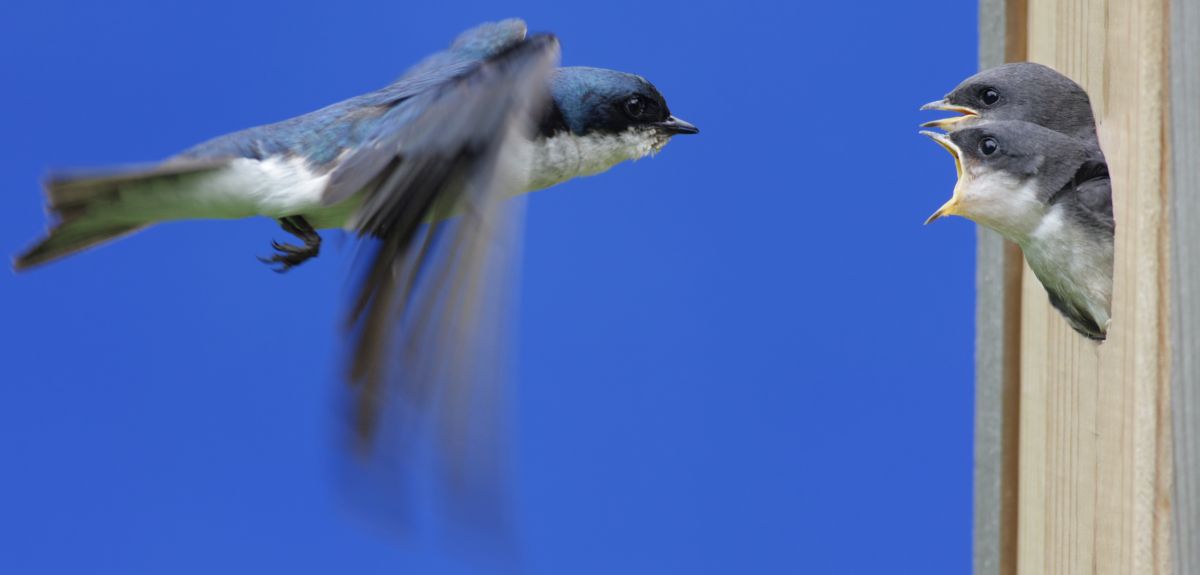
Image credit: Shutterstock
Quality of environment explains why some birds choose to neglect their hungriest chicks
Scientists have long been aware that in some species of bird, parents will prioritise feeding the neediest chicks, whereas in others they will focus on the strongest offspring. Until now, though, the reason behind this discrepancy has remained a mystery.
A comprehensive new study from the University of Oxford finds that the quality of the local environment can explain which chicks in a nest a parent bird decides to feed. This helps resolve a long-standing question in ecology about whether parents respond to signals of need (such as how much a chick begs) or signals of quality (such as a chick's colour) when making feeding decisions.
For example, species living in favourable, predictable environments (such as tree swallows in North America) choose to feed begging chicks that are in poorer condition relative to their siblings, whereas parent birds in unfavourable, unpredictable environments (such as blue-footed boobies in the Galápagos Islands) preferentially feed chicks that are in the best condition, regardless of how much other siblings in the nest beg.
The study is published in the journal Nature Communications.
Shana Caro, a PhD student in Oxford's Department of Zoology who led the research, said: 'There have been hundreds of studies looking at the phenomenon of begging in birds, many of which have found strange results and contradictory patterns.
'Our analysis of these studies found that there is a universal explanation for these discrepancies: the predictability and quality of the local environment.'
The researchers compiled the available literature – more than 300 studies – on the parental care preferences during feeding of 143 bird species across the globe and analysed how this variation in care relates to the condition and behaviour of offspring, as well as the environmental conditions in the area in which each species is found.
Shana Caro said: 'In good ecological conditions, such as those with predictable and abundant sources of food, you tend to find that the chicks in greatest need of food make the most noise and do the most begging.
'But when the ecological conditions are less favourable – for example, if the amount of food available is less predictable – it's the highest-quality chicks making the most noise. It's almost like boasting instead of begging – they’re essentially saying "invest in me, I'm the safest bet".
'In the latter case, parents want to focus their attention on the strongest chicks to make sure at least some of their offspring survive in these unstable environments. Some species, such as the hoopoe, will even try to force-feed bigger chicks when they don’t need food, completely ignoring weaker offspring that are making much more noise.'
The findings indicate that local environmental conditions can influence the evolution of parent-offspring communication systems and explain why previous studies that do not consider environmental variation have not been able to identify consistent behavioural patterns across bird species.
Shana Caro said: 'We also found that there are multiple signalling systems being used simultaneously by chicks. As well as the traditional begging signals such as loud noises and the wide opening of mouths, there are what we call "structural" signals and cues, including how bright orange a chick's mouth is, how big it is, or how much UV light is reflected by special feathers only seen during the nestling period.
'These structural signals are closely associated with high-quality chicks in poor environments. Parents pay more attention to structural cues like body size because they can't be exaggerated – the worse the environment, the more incentive there is for a chick to make more noise in an effort to be the one that survives.'
Senior author Professor Stuart West of Oxford University said: 'By looking at the variation across species we are able to explain why we observe so much variation in the ways animals attempt to get food from their parents.'
The paper 'Unpredictable environments lead to the evolution of parental neglect in birds' is published in Nature Communications.
 Expert Comment: Chatbot-driven sexual abuse? The Grok case is just the tip of the iceberg
Expert Comment: Chatbot-driven sexual abuse? The Grok case is just the tip of the iceberg
 New study finds that stopping weight-loss drugs is linked to faster regain than ending diet programmes
New study finds that stopping weight-loss drugs is linked to faster regain than ending diet programmes